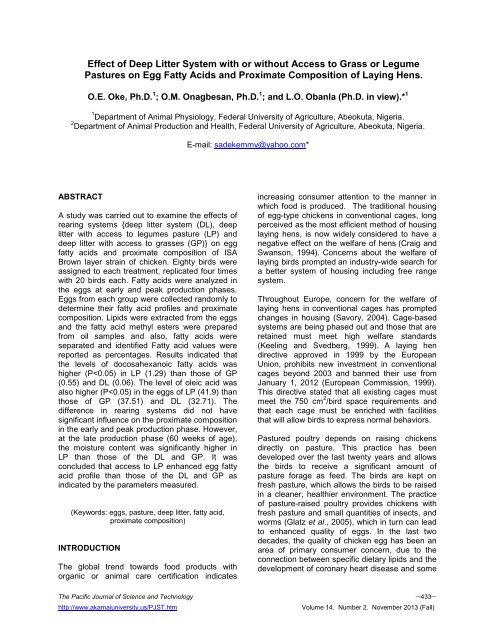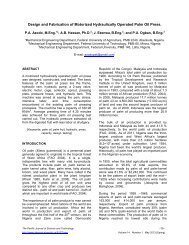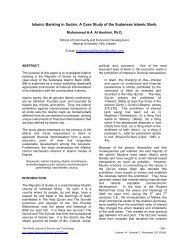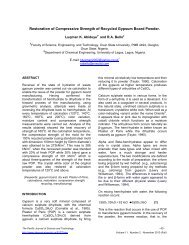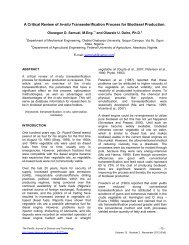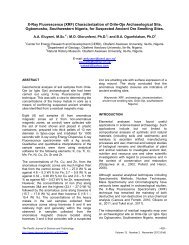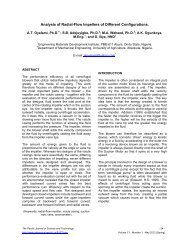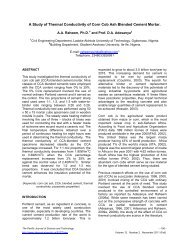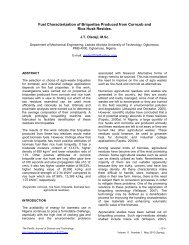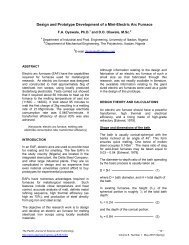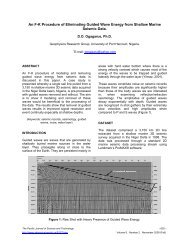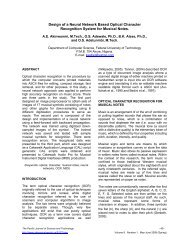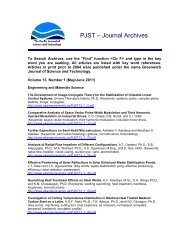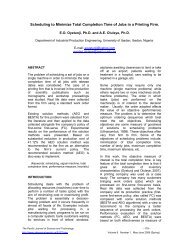Effect of Deep Litter System with or without Access to Grass or ...
Effect of Deep Litter System with or without Access to Grass or ...
Effect of Deep Litter System with or without Access to Grass or ...
Create successful ePaper yourself
Turn your PDF publications into a flip-book with our unique Google optimized e-Paper software.
<strong>Effect</strong> <strong>of</strong> <strong>Deep</strong> <strong>Litter</strong> <strong>System</strong> <strong>with</strong> <strong>or</strong> <strong>with</strong>out <strong>Access</strong> <strong>to</strong> <strong>Grass</strong> <strong>or</strong> Legume<br />
Pastures on Egg Fatty Acids and Proximate Composition <strong>of</strong> Laying Hens.<br />
O.E. Oke, Ph.D. 1 ; O.M. Onagbesan, Ph.D. 1 ; and L.O. Obanla (Ph.D. in view).* 1<br />
1 Department <strong>of</strong> Animal Physiology, Federal University <strong>of</strong> Agriculture, Abeokuta, Nigeria.<br />
2 Department <strong>of</strong> Animal Production and Health, Federal University <strong>of</strong> Agriculture, Abeokuta, Nigeria.<br />
E-mail: sadekemmy@yahoo.com*<br />
ABSTRACT<br />
A study was carried out <strong>to</strong> examine the effects <strong>of</strong><br />
rearing systems {deep litter system (DL), deep<br />
litter <strong>with</strong> access <strong>to</strong> legumes pasture (LP) and<br />
deep litter <strong>with</strong> access <strong>to</strong> grasses (GP)} on egg<br />
fatty acids and proximate composition <strong>of</strong> ISA<br />
Brown layer strain <strong>of</strong> chicken. Eighty birds were<br />
assigned <strong>to</strong> each treatment, replicated four times<br />
<strong>with</strong> 20 birds each. Fatty acids were analyzed in<br />
the eggs at early and peak production phases.<br />
Eggs from each group were collected randomly <strong>to</strong><br />
determine their fatty acid pr<strong>of</strong>iles and proximate<br />
composition. Lipids were extracted from the eggs<br />
and the fatty acid methyl esters were prepared<br />
from oil samples and also, fatty acids were<br />
separated and identified Fatty acid values were<br />
rep<strong>or</strong>ted as percentages. Results indicated that<br />
the levels <strong>of</strong> docosahexanoic fatty acids was<br />
higher (P
f<strong>or</strong>ms <strong>of</strong> cancer (Simopoulos and Salem, 1992).<br />
Due <strong>to</strong> the health benefits associated <strong>with</strong> the<br />
consumption <strong>of</strong> polyunsaturated fatty acids<br />
(PUFA), much research has been carried out <strong>to</strong><br />
enrich eggs <strong>with</strong> these fatty acids (Van Elswyk et<br />
al.,1992). Inclusion <strong>of</strong> pasture species in the feed<br />
<strong>of</strong> chicken provides a unique method <strong>of</strong><br />
manipulating the content <strong>of</strong> some micronutrients<br />
<strong>with</strong> a view <strong>to</strong> improving the nutrient intake <strong>of</strong><br />
consumers <strong>or</strong> improving their overall health.<br />
Yannakopoulos et al. (2005) rep<strong>or</strong>ted that feeding<br />
flaxseed <strong>to</strong> laying hens increases the omega-3<br />
fatty acid in the egg by 6 <strong>to</strong> 8 times, making one<br />
egg equal <strong>to</strong> 114 g <strong>of</strong> cold water fish as source <strong>of</strong><br />
the omega-3 fatty acids. The beneficial effects <strong>of</strong><br />
omega-3 fatty acids include reducing heart<br />
disease, reducing circulating cholesterol levels<br />
and suppressing inflammation. The current<br />
recommended ratio <strong>of</strong> omega-6 <strong>to</strong> omega-3<br />
intake is 1 <strong>to</strong> 4, while the Western diet provides a<br />
ratio approximately 20 <strong>to</strong> 1. This imbalance is<br />
being linked <strong>to</strong> such problems as heart attacks,<br />
diabetes, cancer, etc. in humans and animals<br />
(Klatt, 1986). By eating various grasses and<br />
herbs, free-range layers enrich their food and<br />
assimilate valuable natural nutrients that influence<br />
some egg quality traits (Nys, 2000; Van Den<br />
Brand et al., 2004).<br />
Pastures are assumed <strong>to</strong> be good sources <strong>of</strong> -<br />
linolenic acid (ALA) and other bioactive<br />
compounds. It may constitute a source <strong>of</strong> energy<br />
and protein f<strong>or</strong> birds raised in free-range systems<br />
as the presence <strong>of</strong> a large range <strong>of</strong> bioactive<br />
compounds in the f<strong>or</strong>age, such as xanthophylls<br />
and several hypocholesterolemic and<br />
anticarcinogenic compounds, may lead <strong>to</strong><br />
improvement in poultry meat quality (Ponte et al.,<br />
2008). The nutrients from the f<strong>or</strong>age serve as a<br />
precurs<strong>or</strong> f<strong>or</strong> Omega-3 essential fatty acid. There<br />
is theref<strong>or</strong>e a need <strong>to</strong> carry out a study <strong>to</strong><br />
establish the benefits <strong>of</strong> free-range production<br />
system on the welfare, behaviour and<br />
perf<strong>or</strong>mance <strong>of</strong> the birds. It is also desirable <strong>to</strong><br />
establish which <strong>of</strong> the pasture species would<br />
provide greater benefits <strong>to</strong> quality <strong>of</strong> products and<br />
the welfare <strong>of</strong> the birds.<br />
MATERIALS AND METHODS<br />
Experimental Site<br />
University <strong>of</strong> Agriculture, Abeokuta, Ogun State,<br />
Nigeria. It is located <strong>with</strong>in the rainf<strong>or</strong>est zone <strong>of</strong><br />
south western Nigeria at latitude 7 0 13’, 49 0 46’N,<br />
longitude 3 0 26’, 11 0 98’E and altitude 76mm<br />
above sea. The climate is humid <strong>with</strong> a mean<br />
annual rainfall <strong>of</strong> 1037mm. The annual mean<br />
temperature and humidity are usually 34 0 C and<br />
82 % respectively (Amujoyegbe et al., 2008).<br />
Paddock Establishment<br />
Pri<strong>or</strong> <strong>to</strong> the establishment <strong>of</strong> the paddock, the<br />
land was ploughed and harrowed. Cynodon<br />
dactylon was established vegetatively (<strong>with</strong> the<br />
use <strong>of</strong> sprigs). The sprigs were planted at 7m³/ha<br />
in<strong>to</strong> a well prepared seedbed. Stylosanthes<br />
hamata seeds were scarified using hot water<br />
treatment and then sown at the rate <strong>of</strong> 3kg <strong>of</strong><br />
seed/ha. Irrigation was practiced during the dry<br />
season <strong>with</strong> the source <strong>of</strong> water from a b<strong>or</strong>ehole.<br />
Experimental Birds, Materials and<br />
Management<br />
A <strong>to</strong>tal number <strong>of</strong> 240 Isa-Brown pullets were<br />
obtained from a reputable commercial farm<br />
(Animal Care, Ogere, Nigeria). Birds were housed<br />
under three experimental groups viz. deep litter,<br />
deep litter <strong>with</strong> access <strong>to</strong> a grass-based pasture<br />
and deep litter <strong>with</strong> access <strong>to</strong> a legume-based<br />
pasture. Nesting boxes, perches, feeding and<br />
water troughs were provided in the houses. The<br />
s<strong>to</strong>cking density <strong>of</strong> 7 hens/m 2 was used.<br />
Four replicates <strong>of</strong> 20 birds (a <strong>to</strong>tal <strong>of</strong> 80 birds per<br />
treatment) were used f<strong>or</strong> each <strong>of</strong> the experimental<br />
groups. During the experimental period, the birds<br />
<strong>with</strong> access <strong>to</strong> pasture had access <strong>to</strong> outdo<strong>or</strong> run<br />
during the day light (8.00 am-6.00 pm). Water and<br />
feed were provided ad libitum.<br />
About 8-10 cm depth <strong>of</strong> wood shavings was used<br />
as bedding. Routine and occasional management<br />
practices in poultry production were carried out.<br />
Feeders and drinkers were cleaned, and litter was<br />
changed as at when due. Sanitation <strong>of</strong> the<br />
environment was maintained throughout the<br />
experimental period. The experimental diet is<br />
shown in Table 1. The proximate composition <strong>of</strong><br />
Stylosanthes hamata and Cynodon dactylon are<br />
shown in Table 2 and 3, respectively.<br />
This study was carried out at the Teaching and<br />
Research Farms Direct<strong>or</strong>ate (TREFAD), Federal<br />
The Pacific Journal <strong>of</strong> Science and Technology –434–<br />
http://www.akamaiuniversity.us/PJST.htm<br />
Volume 14. Number 2. November 2013 (Fall)
Table 1: Percentage Composition <strong>of</strong> Layer Diet<br />
used in the Experiment.<br />
Ingredient<br />
Percentage<br />
Maize 48<br />
Soybeans 11<br />
Groundnut cake 8.75<br />
Fishmeal 1.5<br />
Palm kernel cake 5<br />
Wheat <strong>of</strong>fal 14.00<br />
Bone meal 2.5<br />
Limes<strong>to</strong>ne 8.5<br />
*Premix 0.25<br />
Salt 0.25<br />
Lysine 0.1<br />
Methionine 0.15<br />
Total 100<br />
Calculated feed Analysis<br />
Me (Kcal/kg) 2,489.05<br />
CP (%) 17.13<br />
CF (%) 4.30<br />
Ether extract (%) 4.30<br />
Calcium (%) 4.11<br />
Phosph<strong>or</strong>us (%) 0.92<br />
Lysine (%) 0.88<br />
Methionine (%) 0.44<br />
*Supplied per kg diet: Biotin = 40gm; Zn = 58mg; Fe = 5800mg;<br />
Vit A = 1,000,000 i.u , Folic acid = 500mg; Se = 120mg; 1 =<br />
60mg; Nic<strong>to</strong>tinic acid = 2800mg; Cu = 700mg; Mn = 4800mg;<br />
Vit k = 1,500mg; Rib<strong>of</strong>lavin = 500gm; Co = 300g<br />
Table 2: Chemical Composition <strong>of</strong> Stylosanthes<br />
hamate.<br />
Moisture content (%) 81.22<br />
Dry matter (%) 18.76<br />
Crude protein (%) 4.16<br />
Fibre content (%) 1.16<br />
Carbohydrate (%) 10.01<br />
Ash content(%) 1.07<br />
Sodium (mg/g) 2.67<br />
Potassium (mg/g) 4.66<br />
Phosph<strong>or</strong>us (mg/g) 2.12<br />
Magnesium (mg/g) 0.61<br />
Calcium (mg/g) 0.77<br />
Iron (mg/g) 1.89<br />
Zinc (mg/g) 0.02<br />
Table 3: Chemical Composition <strong>of</strong> Cynodon<br />
dactylon.<br />
Moisture content (%) 76.78<br />
Dry matter (%) 23.22<br />
Crude protein (%) 2.10<br />
Fibre content (%) 1.02<br />
Carbohydrate (%) 14.36<br />
Ash content (%) 1.18<br />
Sodium (mg/g) 2.12<br />
Potassium (mg/g) 6.78<br />
Phosph<strong>or</strong>us (mg/g) 1.27<br />
Magnesium (mg/g) 0.73<br />
Calcium (mg/g) 0.77<br />
Iron (mg/g) 1.24<br />
Zinc (mg/g) 0.01<br />
Fatty Acid Determination<br />
Eggs from each group were collected <strong>to</strong><br />
determine their fatty acid pr<strong>of</strong>iles. Lipids were<br />
extracted from eggs by the method <strong>of</strong> the AOAC<br />
(2000). The fatty acid methyl esters were<br />
prepared from oil samples acc<strong>or</strong>ding <strong>to</strong> IUPAC<br />
(1976) and from subsequent fatty acid pr<strong>of</strong>iles<br />
determined by gas chroma<strong>to</strong>graphy. The gas<br />
chroma<strong>to</strong>graphic analysis <strong>of</strong> the sample was<br />
perf<strong>or</strong>med on an Agilent Technologies GC Model:<br />
7890A interfaced <strong>with</strong> Mass Selective Detect<strong>or</strong><br />
model: 5975C (MSD). The electron ionization was<br />
at a 70v <strong>with</strong> an ion source temperature at<br />
250 o C. Highly pure helium gas (99.9% purity)<br />
was used as carrier gas, while HP-5ms (30mm X<br />
0.25mm X 0.320µm) was used as the stationary<br />
phase. The oven temperature was at 100 o C held<br />
f<strong>or</strong> 4 minutes and ramped <strong>to</strong> 270 o C at the rate <strong>of</strong><br />
3.5 o C/minutes holding f<strong>or</strong> 6 minutes. 1µ/l was<br />
au<strong>to</strong> injected. Peaks separated, were identified by<br />
comparison <strong>with</strong> standard samples <strong>of</strong> known<br />
composition. Internal standard (Sigma cat no:<br />
189-19) was used f<strong>or</strong> fatty acid quantification.<br />
Fatty acid values were rep<strong>or</strong>ted as percentages.<br />
Proximate Analysis<br />
The egg white was separated from the egg yolk<br />
and the chalazae were removed. The yolk was<br />
carefully rolled on filter paper (Whatman No. 4,<br />
Whatman International Ltd., Maids<strong>to</strong>ne, UK) <strong>to</strong><br />
remove chalazae and traces <strong>of</strong> albumen adhering<br />
<strong>to</strong> the vitelline membrane. The vitelline membrane<br />
was then disrupted <strong>with</strong> a scalpel blade and yolk<br />
was collected in a beaker. The proximate<br />
composition (moisture, ash, protein, and lipid<br />
The Pacific Journal <strong>of</strong> Science and Technology –435–<br />
http://www.akamaiuniversity.us/PJST.htm<br />
Volume 14. Number 2. November 2013 (Fall)
content) <strong>of</strong> whole egg, egg white, and yolk was<br />
analyzed following the AOAC methods (AOAC,<br />
2000).<br />
Statistical Design and Analysis<br />
The data collected were analyzed using a<br />
completely randomized design. The model is<br />
shown below:<br />
Y ij = μ + T i + Σ ij<br />
Y ij = Observed value <strong>of</strong> dependent variable<br />
μ = Population mean<br />
T i = <strong>Effect</strong> <strong>of</strong> i th rearing system<br />
Σ ij = Residual err<strong>or</strong>.<br />
RESULTS<br />
Table 4 shows the effects <strong>of</strong> rearing system on<br />
egg fatty acid composition during early<br />
production. There was no significant difference in<br />
the levels <strong>of</strong> myristic, palmitic, margaric, stearic,<br />
butyric and pami<strong>to</strong>leic, and eicosenoic acids.<br />
Oleic acid was m<strong>or</strong>e abundant (P
Table 5: <strong>Effect</strong>s <strong>of</strong> Rearing <strong>System</strong> on Egg Fatty Acid Composition (as % <strong>of</strong> <strong>to</strong>tal fatty acids)<br />
at 60 Weeks old.<br />
Parameters Rearing systems SEM<br />
<strong>Deep</strong> litter Legume pasture <strong>Grass</strong> pasture<br />
Myristic 0.07 b 0.19 a 0.14 a 0.02<br />
Palmitic 28.20 26.70 26.00 0.45<br />
Margaric 0.15 0.13 0.15 0.01<br />
Stearic 11.20 a 10.20 b 10.40 b 0.15<br />
Palmi<strong>to</strong>leic 1.30 a 0.21 b 0.30 b 0.16<br />
Oleic 32.71 c 41.90 a 37.51 b 37.37<br />
Myris<strong>to</strong>leic 0.75 c 1.07 a 0.87 b 0.42<br />
Eicosenoic 0.18 ab 0.11 b 0.23 a 0.02<br />
Eicosadienoic 11.9 a 9.95 b 10.20 b 0.30<br />
Arachidonic 3.31 3.47 3.52 0.07<br />
Eicosapentenoic 0.00 b 0.07 a 0.02 b 0.01<br />
Docosapentenoic 0.00 c 0.14 a 0.07 b 0.02<br />
Docosahexanoic 0.06 c 1.29 a 0.55 b 0.15<br />
abc Means <strong>with</strong>in rows <strong>with</strong> different superscripts are significantly different (P
Parameters<br />
Table 6: <strong>Effect</strong>s <strong>of</strong> Rearing <strong>System</strong>s on the Proximate Analysis <strong>of</strong> Eggs.<br />
Rearing systems<br />
<strong>Deep</strong> litter Legume pasture <strong>Grass</strong> pasture<br />
(24 weeks old)<br />
Moisture content (%) 74.78+0.54 75.99+0.68 76.17+1.32<br />
Dry matter content (%) 25.48+0.98 24.01+0.66 23.83+1.32<br />
Fat (%) 8.90+0.72 7.88+0.64 7.80+0.76<br />
Ash (%) 0.89+0.04 0.85+0.03 0.82+0.04<br />
Crude Protein (%) 15.17+0.26 14.93+0.15 14.77+0.53<br />
Carbohydrate (%) 0.52+0.05 0.45+0.04 0.44+0.03<br />
(38 weeks old)<br />
Moisture content (%) 78.47+0.65 78.73+0.72 77.81+0.64<br />
Dry matter content (%) 21.54+0.65 21.27+0.72 22.200.64<br />
Fat (%) 6.23+0.43 5.87+0.39 6.60+0.35<br />
Ash (%) 0.76+0.03 0.74+0.03 0.77+0.04<br />
Crude Protein (%) 14.11+0.27 14.29+0.37 14.390.30<br />
Carbohydrate (%) 0.43+0.03 0.37+0.02 0.43+0.04<br />
(60 weeks old)<br />
Moisture content (%) 75.70+0.51 b 77.84+0.34 a 76.36+0.61 b<br />
Dry matter content (%) 24.23+0.51 a 22.16+0.34 b 23.65+0.61 a<br />
Fat (%) 7.10+0.22 a 6.02+0.12 b 6.79+0.17 a<br />
Ash (%) 0.80+0.02 a 0.74+0.00 b 0.80+0.02 a<br />
Crude Protein (%) 15.79+0.28 14.91+0.20 15.49+0.41<br />
Carbohydrate (%) 0.61+0.03 a 0.49+0.03 b 0.55+0.04 ab<br />
ab Means <strong>with</strong>in rows <strong>with</strong> different superscripts are significantly different (P
4. Craig, J.V. and J.C. Swanson. 1994. “Review.<br />
Welfare perspectives on Hens kept f<strong>or</strong> Egg<br />
Production”. Poultry Sci. 73:921–938.<br />
5. European Commission. 1999. “Council Directive<br />
1999/74/EC <strong>of</strong> 19 July 1999 Laying Down Minimum<br />
Standards f<strong>or</strong> the Protection <strong>of</strong> Laying Hens”. Off.<br />
J. L 203, 03/08/1999.<br />
6. Glatz, P.C., Y.J. Ru, Z.H. Miao, S.K. Wyatt, and<br />
B.J. Rodda. 2005. “Integrating Poultry in<strong>to</strong> a Crop<br />
and Pasture Farming <strong>System</strong>”. International<br />
Journal <strong>of</strong> Poultry Science. 4(4):187-191.<br />
7. Hussein, A.A., A. Idris, B.H. Aeljack, and T.I.<br />
Mohamed. 2012. “<strong>Effect</strong> <strong>of</strong> Age, Season and<br />
Housing <strong>System</strong> on Cholesterol and Fatty Acids<br />
Contents <strong>of</strong> Table Eggs”. Res. Opin. Anim. Vet.<br />
Sci. 2:35-39.<br />
8. Jarosław, O.H., G. C. Ross, A,. K. Józef, C.<br />
Wojciech, K. Wiesław, and K. Magdalena. 2003.<br />
“Content and Fatty Acid Composition <strong>of</strong> Egg Yolk<br />
<strong>of</strong> Grey Nandu (Rhea americana)”. Animal<br />
Science Papers and Rep<strong>or</strong>ts. 21: 265-269.<br />
9. Karsten, H.D., G.L. Crews, R.C. S<strong>to</strong>ut, and P.H.<br />
Patterson. 2003. “The Impact <strong>of</strong> Outdo<strong>or</strong> Coop<br />
Housing and F<strong>or</strong>age Based Diets vs. Cage<br />
Housing and Mash Diets on Hen Perf<strong>or</strong>mance, Egg<br />
Composition and Quality”. International Poultry<br />
Scientific F<strong>or</strong>um. ABS. Atlanta, Ge<strong>or</strong>gia.<br />
10. Keeling, L. and J. Svedberg. 1999. “Legislation<br />
Canning Conventional Battery Cages in Sweden<br />
and Subsequent Phase-out Programme.” Swedish<br />
University <strong>of</strong> Agricultural Sciences: Skara, Sweden.<br />
11. Klatt, L. 1986. “The Lure <strong>of</strong> Omega-3<br />
Polyunsaturated Fatty Acids”. Food Science<br />
Newsletter. 16:1-4.<br />
12. Lopez-Bote, C.J., R.S. Arias, A.I. Rey, A. Castano,<br />
B. Isabel, and J. Thos. 1998. “<strong>Effect</strong> <strong>of</strong> Free Range<br />
Feeding on n-3 Fatty Acid and Alpha-Tocopherol<br />
Content and Oxidative Stability <strong>of</strong> Eggs”. Anim.<br />
Feed. Sci. Technol. 72:33-40.<br />
13. Michael, L.B., L.D. Janet, and P.F. Edward. 2000.<br />
Clinical Chemistry 4th (Ed.), Lippincott Williams<br />
and Wilkins: New Y<strong>or</strong>k, NY. 188-189.<br />
14. Nys, Z. 2000. “Dietary Carotenoids and Egg Yolk<br />
Col<strong>or</strong>ation- A Review”. Arch. Geglugelkd. 64:45-<br />
54.<br />
15. Ponte, P.I.P., J.A.M. Prates, J.P. Crespo, D.G.<br />
Crespo, J.L. Mourao, S.P. Alves, R.J.B. Bessa,<br />
M.A. Chaveiro-Soares, L.T. Gama, L.M.A. Ferreira,<br />
and C.M.G.A. Fontes. 2008. “Restricting the Intake<br />
<strong>of</strong> a Cereal-Based Feed in Free-Range-Pastured<br />
Poultry: <strong>Effect</strong>s on Perf<strong>or</strong>mance and Meat<br />
Quality”. Poultry Science. 87:2032-2042.<br />
16. Radu-Rusu, R.M., M.G. Usturoi, G.R. Cristina and<br />
I. Vacaru-Opriş. 2012. Nutritional Peculiarities Of<br />
The Hen Eggs Produced Within Improved Cages<br />
Or Free Range Alternative <strong>System</strong>s. Lucrări<br />
Ştiinţifice - Seria Zootehnie. Vol. 57.<br />
17. Sav<strong>or</strong>y, C.J. 2004. “Laying Hen Welfare<br />
Standards: A Classic Case <strong>of</strong> "Power <strong>to</strong> the<br />
People". Animal Welfare. 13:S153–S158.<br />
18. Simopoulos, A. P. and N. Salem. 1992. “Egg Yolk<br />
as a Source <strong>of</strong> Long-Chain Polyunsaturated Fatty<br />
Acids in Infant Feeding”. American Journal <strong>of</strong><br />
Clinical Nutrition. 55: 411-414.<br />
19. Van Elswyk, M.E., A.R. Sams, and P.S. Hargis.<br />
1992. “Composition, Functionality, and Sens<strong>or</strong>y<br />
Evaluation <strong>of</strong> Eggs from Hens Dietary Menhaden<br />
Oil”. Journal <strong>of</strong> Food Science. 57:342-344, 349.<br />
20. Yannakopoulos, A., A. Tserveni-Gousi, and E.<br />
Christaki. 2005. “Enhanced Egg Production in<br />
Practice: The Case <strong>of</strong> Bio-Omega-3 Egg”.<br />
International Journal <strong>of</strong> Poultry Science. 4: 531-<br />
535.<br />
ABOUT THE AUTHORS<br />
Dr. O.E. Oke, is a Lecturer at the Department <strong>of</strong><br />
Animal Physiology, Federal University <strong>of</strong><br />
Agriculture, Abeokuta, Nigeria. He is a registered<br />
Animal Scientist and a member <strong>of</strong> Nigerian<br />
Institute <strong>of</strong> Animal Science. He holds a Ph.D. in<br />
Animal Physiology from the Federal University <strong>of</strong><br />
Agriculture, Abeokuta, Nigeria. His research<br />
interests are in growth and reproductive<br />
physiology <strong>of</strong> farm animals.<br />
Pr<strong>of</strong>ess<strong>or</strong> O.M. Onagbesan, is a Pr<strong>of</strong>ess<strong>or</strong> <strong>of</strong><br />
Animal Physiology in the Department <strong>of</strong> Animal<br />
Physiology, Federal University <strong>of</strong> Agriculture,<br />
Abeokuta, Nigeria.<br />
L.O. Obanla, is a Research Scientist in the field<br />
<strong>of</strong> animal reproductive physiology, Department <strong>of</strong><br />
Animal Physiology, College <strong>of</strong> Animal Science<br />
and Lives<strong>to</strong>ck Production, Federal University <strong>of</strong><br />
Agriculture, Abeokuta, Nigeria. He is a doct<strong>or</strong>ate<br />
student at the above named department.<br />
The Pacific Journal <strong>of</strong> Science and Technology –439–<br />
http://www.akamaiuniversity.us/PJST.htm<br />
Volume 14. Number 2. November 2013 (Fall)
SUGGESTED CITATION<br />
Oke, O.E., O.M. Onagbesan, and L.O. Obanla.<br />
2013. “<strong>Effect</strong> <strong>of</strong> <strong>Deep</strong> <strong>Litter</strong> <strong>System</strong> <strong>with</strong> <strong>or</strong> <strong>with</strong>out<br />
<strong>Access</strong> <strong>to</strong> <strong>Grass</strong> <strong>or</strong> Legume Pastures on Egg<br />
Fatty Acids and Proximate Composition <strong>of</strong> Laying<br />
Hens”. Pacific Journal <strong>of</strong> Science and<br />
Technology. 14(2):433-440.<br />
Pacific Journal <strong>of</strong> Science and Technology<br />
The Pacific Journal <strong>of</strong> Science and Technology –440–<br />
http://www.akamaiuniversity.us/PJST.htm<br />
Volume 14. Number 2. November 2013 (Fall)


